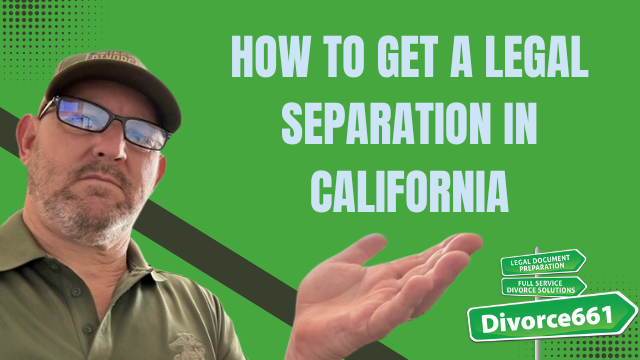How to Get a Legal Separation in California
I’m Tim Blankenship from Divorce661. If you’re weighing divorce but not ready to end your marriage, there’s an important alternative to consider: legal separation in California. In this article I’ll walk you through what legal separation is, how the process works, who it helps, and how to get started—step by step.
What is legal separation?
Legal separation is a court-approved process that looks a lot like divorce in terms of resolving financial and parenting issues—but it leaves you legally married. That means you can divide assets, set support arrangements, and obtain court-ordered custody decisions while maintaining your marital status.
Legal separation mirrors divorce, but keeps you legally married.
Why choose legal separation instead of divorce?
- Religious or personal beliefs: Some couples wish to remain married for religious reasons or personal convictions but still need legal clarity about finances and parenting.
- Health insurance and benefits: Staying legally married can preserve eligibility for employer-sponsored health insurance and other benefits.
- Financial planning: Legal separation allows you to separate finances and property without triggering the finality of divorce.
- Time to decide: It gives couples space to address practical matters without permanently ending the marriage.
How legal separation works in California: a step-by-step guide
The legal separation process in California follows many of the same steps as a divorce. Here’s a straightforward breakdown:
- File the petition: One spouse files a petition with the court to start the legal separation. This initiates the legal process while keeping the marital status intact.
- Serve your spouse: The filing spouse must ensure the other spouse is properly served with the legal papers, which gives them formal notice and the opportunity to respond.
- Exchange financial disclosures: Both parties must disclose assets, debts, income, and expenses—this is required for fair division and support calculations.
- Resolve key issues: You’ll address custody and parenting time for children, child support, spousal support (if applicable), and division of community property and debts.
- Reach an agreement or go to court: Most couples resolve issues by agreement (through negotiation or mediation). If needed, the court will decide contested issues.
- Judgment of legal separation: Once terms are finalized, the court issues a judgment of legal separation that sets the legal framework for finances and parenting moving forward.
What issues must be resolved?
Even though you’re not getting divorced, legal separation requires resolving the same practical issues:
- Child custody and visitation (parenting plan)
- Child support calculations and enforcement
- Spousal support (temporary or permanent)
- Division of property and debts (community vs. separate property)
- Insurance, tax, and retirement account handling
A real example
We recently helped a California couple who wanted to remain married for religious reasons but needed to divide assets and set up support arrangements. Legal separation provided a structured, court-enforced solution that honored their beliefs while protecting each spouse’s financial interests and clarifying parenting responsibilities. They got the certainty and legal protections they needed—without finalizing a divorce.
Benefits and limitations
- Benefits: Maintains marital status, preserves benefits like health insurance, creates enforceable orders for support and custody, and provides financial clarity.
- Limitations: You remain legally married, so remarriage isn’t possible unless you later convert the separation into a divorce. Also, some people mistakenly assume separation automatically changes tax or benefit eligibility—these must be checked with employers or tax advisors.
How Divorce661 can help
At Divorce661 we provide full-service legal separation support tailored for amicable or cooperative situations. Our services include filing, serving, preparing disclosures, negotiating agreements, and finalizing the judgment—start to finish—so you don’t have to navigate confusing paperwork or multiple court appearances.
- Flat-fee pricing with no surprise bills
- 100% remote service—handle everything from home
- We prepare and file paperwork, serve documents, and manage disclosures and agreements
- No court hassle for many cases when couples reach agreement
If you want to learn more, schedule a free consultation at Divorce661.com. We’ll walk through your options, explain how legal separation could work for your situation, and help you take the next step with confidence.
Next steps and closing thoughts
Legal separation in California is a flexible, practical option for couples who need legal solutions without ending their marriage. If you’re considering separation for religious reasons, benefits preservation, or to gain financial clarity, it’s worth exploring with an experienced provider.
Take a moment to assess your priorities—custody, health insurance, finances, or religious beliefs—and then get guidance. Legal separation can provide peace of mind, enforceable orders, and a clear path forward while preserving the marriage if that’s what you want.
Visit Divorce661.com for a free consultation and to discover whether legal separation is the right option for your family.

